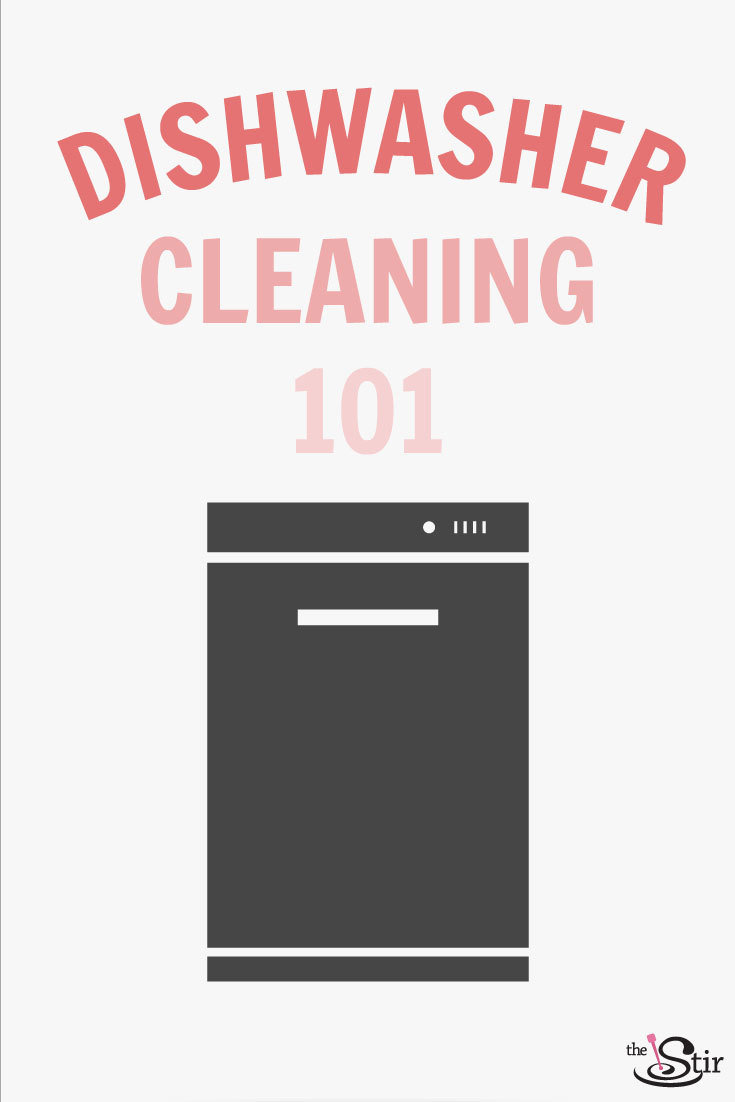But shouldn’t a device designed to tackle dirty dishes be intrinsically clean, at least after you’ve run it, you ask? While that would be nice, unfortunately, that’s not the case.
So, just how do you go about making sure your dishwasher is as germ-free as possible? Cleaning expert Melissa Maker, founder of Clean My Space, shares her solutions for getting your dishwasher in tip-top shape.
- Don’t close it completely. If your dishwasher isn’t in use, leave the door slightly ajar, Maker says. “This will really help with odors,” she recommends.
- Deal with issues right away. If you’ve spotted that pink-y/orange-y slime snaking its way around the door and floor of your washer, you’ll want to tackle it immediately, the cleaning guru notes. “The inside of your dishwasher is a breeding ground for bacteria,” Maker says. “Moisture in a dark environment, plus bacteria from food particles, is feeding mold and mildew. Take some white vinegar on a cloth and wipe the area. You can spray it on as well. It’s unsightly and easy to prevent, but once you have it, you have to know how to manage it.”
- Clean the filter. If you’re embarrassed by your glasses and utensils appearing spotty and far from shiny, it could be time to clean your filter. “You’re going to want to wear gloves and prepare yourself because it can be pretty gross,” Maker says. “At the bottom, you may either see mesh or a grid that’s designed to catch larger food particles. When it’s removed, you’ll see really gross stuff in there like mold and mildew, pet hair, possibly even broken glass. It needs to be cleaned. Remove the filter and soak in a bucket with hot water and a little dish detergent. Soak it for an hour, then take it out. You may need to find a brush to clean the fine particles that get stuck in the mesh. Once it’s cleaned, the water can filter properly. The reason your things aren’t looking their best is because they’re not being cleaned with clean water.” Makes you want to go remove that filter this minute, doesn’t it? Because the location of the filter varies by manufacturer and model, it’s a good idea to grab your manual or check YouTube for a video if it’s not immediately obvious. Maker says if you use your dishwasher daily, you’ll want to clean the filter three to four times per year. More from The Stir: 6 Simple Strategies for Quick & Easy Fridge Cleaning
- Create your own solution. If you want to give your washer a good cleansing after you’ve tackled that filter, sprinkle the bottom with baking soda and leave the door open overnight, Maker suggests. “In the morning, pour a cup of white vinegar into the base and run it. It may fizz up a bit but it’ll be okay. The two work together because they’re acidic and abrasive,” she says.
- Be proactive. The best way to prevent these issues from occurring is to be proactive. Give your plates and utensils a thorough rinsing before placing them in your machine. Maker says every once in a while go around the bottom of your dishwasher with a paper towel to gather up any food particles that haven’t made it into the filter yet. “Use a good quality detergent,” she advises. “If your glasses aren’t coming out as clean as you’d like, try a rinse aid. But the majority of issues when it comes to your dishwasher not performing can be eliminated by cleaning that filter.” Image via scyther5/Shutterstock



title: “5 Steps To A Clean Germ Free Dishwasher” ShowToc: true date: “2024-09-30” author: “Shirley Connelly”
But shouldn’t a device designed to tackle dirty dishes be intrinsically clean, at least after you’ve run it, you ask? While that would be nice, unfortunately, that’s not the case.
So, just how do you go about making sure your dishwasher is as germ-free as possible? Cleaning expert Melissa Maker, founder of Clean My Space, shares her solutions for getting your dishwasher in tip-top shape.
- Don’t close it completely. If your dishwasher isn’t in use, leave the door slightly ajar, Maker says. “This will really help with odors,” she recommends.
- Deal with issues right away. If you’ve spotted that pink-y/orange-y slime snaking its way around the door and floor of your washer, you’ll want to tackle it immediately, the cleaning guru notes. “The inside of your dishwasher is a breeding ground for bacteria,” Maker says. “Moisture in a dark environment, plus bacteria from food particles, is feeding mold and mildew. Take some white vinegar on a cloth and wipe the area. You can spray it on as well. It’s unsightly and easy to prevent, but once you have it, you have to know how to manage it.”
- Clean the filter. If you’re embarrassed by your glasses and utensils appearing spotty and far from shiny, it could be time to clean your filter. “You’re going to want to wear gloves and prepare yourself because it can be pretty gross,” Maker says. “At the bottom, you may either see mesh or a grid that’s designed to catch larger food particles. When it’s removed, you’ll see really gross stuff in there like mold and mildew, pet hair, possibly even broken glass. It needs to be cleaned. Remove the filter and soak in a bucket with hot water and a little dish detergent. Soak it for an hour, then take it out. You may need to find a brush to clean the fine particles that get stuck in the mesh. Once it’s cleaned, the water can filter properly. The reason your things aren’t looking their best is because they’re not being cleaned with clean water.” Makes you want to go remove that filter this minute, doesn’t it? Because the location of the filter varies by manufacturer and model, it’s a good idea to grab your manual or check YouTube for a video if it’s not immediately obvious. Maker says if you use your dishwasher daily, you’ll want to clean the filter three to four times per year. More from The Stir: 6 Simple Strategies for Quick & Easy Fridge Cleaning
- Create your own solution. If you want to give your washer a good cleansing after you’ve tackled that filter, sprinkle the bottom with baking soda and leave the door open overnight, Maker suggests. “In the morning, pour a cup of white vinegar into the base and run it. It may fizz up a bit but it’ll be okay. The two work together because they’re acidic and abrasive,” she says.
- Be proactive. The best way to prevent these issues from occurring is to be proactive. Give your plates and utensils a thorough rinsing before placing them in your machine. Maker says every once in a while go around the bottom of your dishwasher with a paper towel to gather up any food particles that haven’t made it into the filter yet. “Use a good quality detergent,” she advises. “If your glasses aren’t coming out as clean as you’d like, try a rinse aid. But the majority of issues when it comes to your dishwasher not performing can be eliminated by cleaning that filter.” Image via scyther5/Shutterstock



title: “5 Steps To A Clean Germ Free Dishwasher” ShowToc: true date: “2024-09-09” author: “Jackie Bunn”
But shouldn’t a device designed to tackle dirty dishes be intrinsically clean, at least after you’ve run it, you ask? While that would be nice, unfortunately, that’s not the case.
So, just how do you go about making sure your dishwasher is as germ-free as possible? Cleaning expert Melissa Maker, founder of Clean My Space, shares her solutions for getting your dishwasher in tip-top shape.
- Don’t close it completely. If your dishwasher isn’t in use, leave the door slightly ajar, Maker says. “This will really help with odors,” she recommends.
- Deal with issues right away. If you’ve spotted that pink-y/orange-y slime snaking its way around the door and floor of your washer, you’ll want to tackle it immediately, the cleaning guru notes. “The inside of your dishwasher is a breeding ground for bacteria,” Maker says. “Moisture in a dark environment, plus bacteria from food particles, is feeding mold and mildew. Take some white vinegar on a cloth and wipe the area. You can spray it on as well. It’s unsightly and easy to prevent, but once you have it, you have to know how to manage it.”
- Clean the filter. If you’re embarrassed by your glasses and utensils appearing spotty and far from shiny, it could be time to clean your filter. “You’re going to want to wear gloves and prepare yourself because it can be pretty gross,” Maker says. “At the bottom, you may either see mesh or a grid that’s designed to catch larger food particles. When it’s removed, you’ll see really gross stuff in there like mold and mildew, pet hair, possibly even broken glass. It needs to be cleaned. Remove the filter and soak in a bucket with hot water and a little dish detergent. Soak it for an hour, then take it out. You may need to find a brush to clean the fine particles that get stuck in the mesh. Once it’s cleaned, the water can filter properly. The reason your things aren’t looking their best is because they’re not being cleaned with clean water.” Makes you want to go remove that filter this minute, doesn’t it? Because the location of the filter varies by manufacturer and model, it’s a good idea to grab your manual or check YouTube for a video if it’s not immediately obvious. Maker says if you use your dishwasher daily, you’ll want to clean the filter three to four times per year. More from The Stir: 6 Simple Strategies for Quick & Easy Fridge Cleaning
- Create your own solution. If you want to give your washer a good cleansing after you’ve tackled that filter, sprinkle the bottom with baking soda and leave the door open overnight, Maker suggests. “In the morning, pour a cup of white vinegar into the base and run it. It may fizz up a bit but it’ll be okay. The two work together because they’re acidic and abrasive,” she says.
- Be proactive. The best way to prevent these issues from occurring is to be proactive. Give your plates and utensils a thorough rinsing before placing them in your machine. Maker says every once in a while go around the bottom of your dishwasher with a paper towel to gather up any food particles that haven’t made it into the filter yet. “Use a good quality detergent,” she advises. “If your glasses aren’t coming out as clean as you’d like, try a rinse aid. But the majority of issues when it comes to your dishwasher not performing can be eliminated by cleaning that filter.” Image via scyther5/Shutterstock



title: “5 Steps To A Clean Germ Free Dishwasher” ShowToc: true date: “2024-10-08” author: “David Waite”
But shouldn’t a device designed to tackle dirty dishes be intrinsically clean, at least after you’ve run it, you ask? While that would be nice, unfortunately, that’s not the case.
So, just how do you go about making sure your dishwasher is as germ-free as possible? Cleaning expert Melissa Maker, founder of Clean My Space, shares her solutions for getting your dishwasher in tip-top shape.
- Don’t close it completely. If your dishwasher isn’t in use, leave the door slightly ajar, Maker says. “This will really help with odors,” she recommends.
- Deal with issues right away. If you’ve spotted that pink-y/orange-y slime snaking its way around the door and floor of your washer, you’ll want to tackle it immediately, the cleaning guru notes. “The inside of your dishwasher is a breeding ground for bacteria,” Maker says. “Moisture in a dark environment, plus bacteria from food particles, is feeding mold and mildew. Take some white vinegar on a cloth and wipe the area. You can spray it on as well. It’s unsightly and easy to prevent, but once you have it, you have to know how to manage it.”
- Clean the filter. If you’re embarrassed by your glasses and utensils appearing spotty and far from shiny, it could be time to clean your filter. “You’re going to want to wear gloves and prepare yourself because it can be pretty gross,” Maker says. “At the bottom, you may either see mesh or a grid that’s designed to catch larger food particles. When it’s removed, you’ll see really gross stuff in there like mold and mildew, pet hair, possibly even broken glass. It needs to be cleaned. Remove the filter and soak in a bucket with hot water and a little dish detergent. Soak it for an hour, then take it out. You may need to find a brush to clean the fine particles that get stuck in the mesh. Once it’s cleaned, the water can filter properly. The reason your things aren’t looking their best is because they’re not being cleaned with clean water.” Makes you want to go remove that filter this minute, doesn’t it? Because the location of the filter varies by manufacturer and model, it’s a good idea to grab your manual or check YouTube for a video if it’s not immediately obvious. Maker says if you use your dishwasher daily, you’ll want to clean the filter three to four times per year. More from The Stir: 6 Simple Strategies for Quick & Easy Fridge Cleaning
- Create your own solution. If you want to give your washer a good cleansing after you’ve tackled that filter, sprinkle the bottom with baking soda and leave the door open overnight, Maker suggests. “In the morning, pour a cup of white vinegar into the base and run it. It may fizz up a bit but it’ll be okay. The two work together because they’re acidic and abrasive,” she says.
- Be proactive. The best way to prevent these issues from occurring is to be proactive. Give your plates and utensils a thorough rinsing before placing them in your machine. Maker says every once in a while go around the bottom of your dishwasher with a paper towel to gather up any food particles that haven’t made it into the filter yet. “Use a good quality detergent,” she advises. “If your glasses aren’t coming out as clean as you’d like, try a rinse aid. But the majority of issues when it comes to your dishwasher not performing can be eliminated by cleaning that filter.” Image via scyther5/Shutterstock


